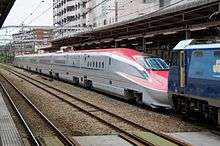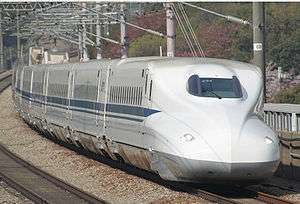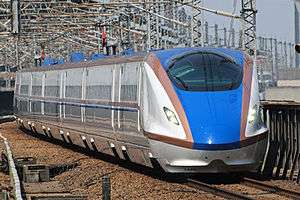E6 Series Shinkansen
The E6 series (E6系) is a Japanese Shinkansen high-speed train type operated by East Japan Railway Company (JR East) on Komachi "mini-shinkansen" services on the Tōhoku Shinkansen and Akita Shinkansen from Tokyo to Akita since 16 March 2013. A pre-series set was delivered in June 2010 for extensive testing, with 23 full-production sets delivered between November 2012 and spring 2014.[1]
| E6 series | |
|---|---|
 E6 series set Z12 in October 2016 | |
| In service | March 2013–present |
| Manufacturer | Hitachi, Kawasaki Heavy Industries |
| Replaced | E3-0 series |
| Constructed | 2010–2014 |
| Number built | 168 vehicles (24 sets) |
| Number in service | 168 vehicles (24 sets) |
| Formation | 7 cars per trainset |
| Fleet numbers | Z1–Z24 |
| Capacity | 338 (315 Standard + 23 Green) |
| Operator(s) | JR East |
| Depot(s) | Akita |
| Line(s) served | Tōhoku Shinkansen, Akita Shinkansen |
| Specifications | |
| Car body construction | Aluminium alloy |
| Train length | 148.65 m (487.7 ft) |
| Car length | 23,075 mm (75 ft 8.5 in) (end cars) 20,500 mm (67 ft 3 in) (intermediate cars) |
| Width | 2,945 mm (9 ft 7.9 in) |
| Height | 3,650 mm (12 ft 0 in) |
| Doors | One per side, plus one cab access door per side per end car |
| Maximum speed | 320 km/h (200 mph) (Tōhoku Shinkansen) 130 km/h (81 mph) (Akita Shinkansen) |
| Weight | 306.5 t (301.7 long tons; 337.9 short tons) |
| Traction system | MT207 AC Motor (300 kW) |
| Power output | 6,000 kW (8,050 hp) |
| Acceleration | 1.71 km/h/s (shinkansen) 2.0 km/h/s (conventional) |
| Electric system(s) | 25 kV AC, 50 Hz overhead catenary (Tōhoku Shinkansen) 20 kV AC, 50 Hz overhead catenary (Akita Shinkansen) |
| Current collection method | Pantograph |
| UIC classification | Bo'Bo'+2'2'+Bo'Bo'+Bo'Bo'+Bo'Bo'+2'2'+Bo'Bo' |
| Bogies | DT210 (motored), TR7009 (trailer) |
| Safety system(s) | DS-ATC, RS-ATC, ATS-P |
| Multiple working | E5 series, H5 series |
| Track gauge | 1,435 mm (4 ft 8 1⁄2 in) standard gauge |
Operations
The 7-car E6 series trains operate in conjunction with E5 series or H5 series (since March 2016) 10-car trains, initially on just four return services daily from 16 March 2013.[2] They replaced all of the previous E3 series trains on Komachi services by 15 March 2014.[3]
Design
Technology incorporated in these trains is derived from the experimental Fastech 360Z train previously tested by JR East. The E6 series trains are formed of seven cars, to provide the same seating capacity as six-car E3 series trains, due to the reduced seating capacity in the end cars. All cars feature active suspension with tilting up to 1.5 degrees.[4]
Formation
Pre-production set S12
The pre-series train, numbered "S12" (later becoming "Z1"), was formed as follows, with car 11 at the Tokyo end and car 17 at the Morioka end.[5]
| Car No. | 11 | 12 | 13 | 14 | 15 | 16 | 17 |
|---|---|---|---|---|---|---|---|
| Designation | M1sc | Tk | M1 | M1 | M1 | T | M1c |
| Numbering | E611 | E628 | E625 | E625-100 | E627 | E629 | E621 |
| Weight (t) | 45.7 | 44.4 | 42.5 | 43.1 | 42.5 | 44.5 | 43.8 |
| Seating capacity | 23 | 35 | 60 | 60 | 68 | 60 | 32 |
- Car 11 provides Green (first class) accommodation.
- Cars 12 and 16 are each fitted with a single-arm pantograph.[6] Like the E5 series, only one pantograph is normally used in service.
- Cars 11 to 14 were built by Kawasaki Heavy Industries, and cars 15 to 17 were built by Hitachi.[6]
 E611-1 (car No. 11)
E611-1 (car No. 11) E628-1 (car No. 12)
E628-1 (car No. 12) E625-1 (car No. 13)
E625-1 (car No. 13) E625-101 (car No. 14)
E625-101 (car No. 14) E627-1 (car No. 15)
E627-1 (car No. 15) E629-1 (car No. 16)
E629-1 (car No. 16) E621-1 (car No. 17)
E621-1 (car No. 17)
Full-production sets Z2–
The full-production trains, numbered "Z2" onward, are formed as follows, with car 11 at the Tokyo end and car 17 at the Morioka end.[7]
| Car No. | 11 | 12 | 13 | 14 | 15 | 16 | 17 |
|---|---|---|---|---|---|---|---|
| Designation | M1sc | Tk | M1 | M1 | M1 | T | M1c |
| Numbering | E611 | E628 | E625 | E625-100 | E627 | E629 | E621 |
| Weight (t) | 45.1 | 44.4 | 41.7 | 41.8 | 42.1 | 44.2 | 43.4 |
| Seating capacity | 22 | 34 | 60 | 60 | 68 | 60 | 32 |
- Car 11 provides Green (first class) accommodation.
- Cars 12 and 16 are each fitted with a single-arm pantograph.[7]
Exterior
The overall styling was overseen by Japanese industrial designer Ken Okuyama, and is intended to evoke images of the Namahage demons and kantō festival lanterns for which Akita Prefecture is famous.[8] The main body colour is "Hiun" (飛雲) white with crimson roof and "arrow silver" bodyside stripe. The end cars are 23,075 mm (75 ft 8.5 in) long with the tapered nose accounting for approximately 13 m (compared with approximately 6 m for the E3 series).[4]
Interior
The new trains feature similar improvements to passenger accommodation as featured on the E5 series trains, including AC power outlets, and security cameras in vestibule areas. Seating in both Standard class and Green (first class) cars is in the standard 2+2 arrangement for mini-shinkansen trains.[7] Seat pitch is 1,160 mm (46 in) in Green class and 980 mm (39 in) in Standard class, the same as for the E3 series trains.[4] Cars 12, 13, 14, and 16 are equipped with toilets.[7] The toilet in car 12 is universal access.[7]
 Green-class car (car 11) interior
Green-class car (car 11) interior Standard-class car (car 12) interior
Standard-class car (car 12) interior An AC power outlet in a standard-class car
An AC power outlet in a standard-class car Wheelchair-accessible toilet in car 12
Wheelchair-accessible toilet in car 12
History
The pre-series set, S12, was delivered to Sendai Depot in June 2010,[9] and formally accepted by JR East on 8 July.[6] Test running commenced on the Tohoku Shinkansen in July 2010.[10]
The first full-production set was delivered in November 2012, with production continuing until spring 2014.[1]
Revenue service commenced on 16 March 2013 on new Super Komachi services, running at a maximum speed of 300 km/h (185 mph) on the Tohoku Shinkansen.[2] From 15 March 2014, the maximum speed was raised to 320 km/h (200 mph) on the Tohoku Shinkansen, with the maximum speed on the Akita Shinkansen tracks remaining at 130 km/h (80 mph), allowing journey times between Tokyo and Akita to be reduced by an average of 12 minutes.[3] The service name was also returned to simply Komachi.[3]
In May 2014, the E6 series was awarded the 2014 Laurel Prize, presented annually by the Japan Railfan Club.[11] The award presentation ceremony was held at Akita Station on 8 November 2014.[12]
Fleet list

As of 1 October 2014, 24 sets were in service, as shown below.[13]
| Set number | Manufacturer | Date delivered | Remarks |
|---|---|---|---|
| Z1 | Hitachi/Kawasaki HI | 8 July 2010 | Pre-series set, originally numbered S12, modified February 2014 |
| Z2 | Kawasaki HI | 19 November 2012 | Full-production sets |
| Z3 | Kawasaki HI | 3 December 2012 | |
| Z4 | Hitachi | 18 December 2012 | |
| Z5 | Hitachi | 14 February 2013 | |
| Z6 | Kawasaki HI | 14 March 2013 | |
| Z7 | Kawasaki HI | 26 April 2013 | |
| Z8 | Kawasaki HI | 18 May 2013 | |
| Z9 | Kawasaki HI | 22 June 2013 | |
| Z10 | Hitachi | 27 June 2013 | |
| Z11 | Kawasaki HI | 12 July 2013 | |
| Z12 | Hitachi | 10 July 2013 | |
| Z13 | Kawasaki HI | 24 August 2013 | |
| Z14 | Hitachi | 30 August 2013 | |
| Z15 | Kawasaki HI | 14 September 2013 | |
| Z16 | Hitachi | 27 September 2013 | |
| Z17 | Kawasaki | 9 October 2013 | |
| Z18 | Hitachi | 25 October 2013 | |
| Z19 | Kawasaki | 1 November 2013 | |
| Z20 | Hitachi | 30 November 2013 | |
| Z21 | Kawasaki | 11 December 2013 | |
| Z22 | Kawasaki | 21 January 2014 | |
| Z23 | Hitachi | 13 February 2014 | |
| Z24 | Hitachi | 3 April 2014 |
While the first sets from both Hitachi and Kawasaki Heavy Industries were delivered by sea to Sendai, set Z9 was delivered from the Kawasaki Heavy Industries factory in Kobe by rail to Akita Depot over three days from 31 May to 2 June 2013, mounted on temporary narrow-gauge (1,067 mm gauge) bogies and hauled by freight locomotives.[14] This was followed by set Z11 from 21 to 23 June 2013.[15]
See also
- List of high speed trains
References
- 秋田新幹線用車両と埼京線・横浜線用車両の新造について [Akita Shinkansen, Saikyo Line, and Yokohama Line new train details] (PDF) (in Japanese). JR East. 10 April 2012. Retrieved 10 April 2012.
- "E6系"スーパーこまち"" [E6 series "Super Komachi"]. Japan Railfan Magazine. Vol. 53 no. 621. Japan: Koyusha Co., Ltd. January 2013. p. 56.
- 3月15日ダイヤ改正と各地の話題 [15 March timetable revision and topics from around the regions]. Tetsudō Daiya Jōhō Magazine (in Japanese). Vol. 43 no. 361. Japan: Kōtsū Shimbun. May 2014. p. 12.
- 新型高速新幹線(E6 系)量産先行車について [E6 series pre-series train details] (PDF) (in Japanese). JR East. 2 February 2010. Retrieved 2 February 2010.
- JR東日本 E6系新幹線電車(量産先行車) [JR East E6 series shinkansen pre-series train]. Tetsudō Daiya Jōhō Magazine. Vol. 39 no. 317. Japan: Kōtsū Shimbun. September 2010. pp. 64–65.
- JR電車編成表 2014夏 [JR EMU Formations - Summer 2014]. Japan: Kotsu Shimbunsha. 30 May 2014. p. 20. ISBN 978-4-330-46614-9.
- Seko, Masayuki (February 2013). E6系量産車 [E6 series full-production train]. Japan Railfan Magazine. Vol. 53 no. 622. Japan: Koyusha Co., Ltd. pp. 54–61.
- 「こまち」の新型車両発表 13年に秋田新幹線に導入 [New Komachi trains unveiled - To be introduced on Akita Shinkansen in 2013]. 47 News (in Japanese). Japan: Press Net Japan Co., Ltd. 2 February 2010. Archived from the original on 4 February 2010. Retrieved 18 September 2012.
- 「あかね色」車体を初披露 秋田新幹線の新型車両 [Crimson Exterior of New Akita Shinkansen Trains Unveiled] (in Japanese). Press Net Japan. 8 June 2010. Archived from the original on 11 June 2010. Retrieved 8 June 2010.
- E6系量産先行車S12編成が試運転を実施 [E6 series pre-series train S12 commences test running]. Japan Railfan Magazine Online (in Japanese). Koyusha Co., Ltd. 8 July 2010. Retrieved 8 July 2010.
- ブルーリボン賞・ローレル賞 選定車両一覧 [Blue Ribbon Award & Laurel Prize Winner List] (in Japanese). Japan: Japan Railfan Club. 26 May 2014. Archived from the original on 26 October 2010. Retrieved 26 May 2014.
- JR東日本E6系福井鉄道F1000形ローレル賞を受賞 [JR East E6 series and Fuikui Railway F1000 series receive Laurel Prize]. Japan Railfan Magazine (in Japanese). Vol. 55 no. 645. Japan: Koyusha Co., Ltd. January 2015. p. 68.
- JR電車編成表 2015冬 [JR EMU Formations - Winter 2015]. Japan: Kotsu Shimbunsha. 21 November 2014. p. 22. ISBN 978-4-330-51614-1.
- Tsujimori (August 2013). 5/31~6/2,E6系新製車が初めての陸路旅 [31 May-2 June: newly built E6 series travels by land for first time]. Japan Railfan Magazine (in Japanese). Vol. 53 no. 628. Japan: Koyusha Co., Ltd. p. 153.
- E6系Z11編成が甲種輸送される [E6 series set Z11 delivered]. Japan Railfan Magazine Online (in Japanese). Japan: Koyusha Co., Ltd. 23 June 2013. Retrieved 24 June 2013.
External links
| Wikimedia Commons has media related to E6 series. |
- JR East E6 series (in Japanese)
- JR East E6 series (Japan Railfan Magazine Online) (in Japanese)

